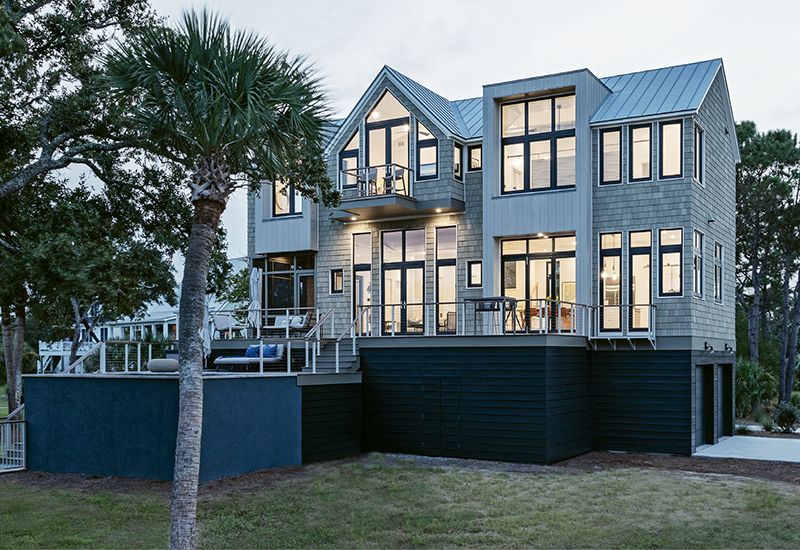One couple’s retirement dream come true

It’s entirely plausible that nature lovers Steve and Heidi Newman would be happy living in a tent on their large Edisto Island lot. But practicalities called for something a tad more substantial. The couple, who relocated from Nashville, Tennessee, early last year for their retirement, were in search of simpler living and a slower lifestyle. They wanted a contemporary house that prioritized a sense of place over space for stuff and a home base for indulging in their shared passions of gardening, wildlife watching, and spending time by the ocean. “Basically, we wanted as minimal a barrier between the outside and inside as we could possibly get,” explains Steve.
A former technical diver (him) and a pathologist (her), the Newmans have traveled far and wide, from the Bahamas to Bali, including African safaris, South Pacific diving adventures, and tours of cities throughout Europe. But Edisto Beach is “about the most amazing place we’ve been,” says Steve. It’s here the couple’s quest for a quiet place by the water ended when they found their personal slice of heaven on the banks of Scott Creek. Within a few hours of arriving on the sea island south of Charleston, they were sold. “We made an offer on the lot that day,” says Steve of the marshfront oasis with wide ocean views.
Bucking the trend of “bigger is better,” the Newmans tasked their Charleston-based architect, Myles Trudell, and Edisto builder, Terry Hoff, with constructing the smallest home practical on the oversized lot (they purchased two adjacent parcels to provide extra space for a garden). “As it was basically just for the two of them, they wanted it to be as efficient as possible,” explains Trudell. The result was a 2,300-square-foot, two-bedroom home that provides a connection to the outdoors at every possible point.

Inside, the desire for a cleaner, simpler way of life led to an open plan filled with light. “They wanted the furnishings to be fairly uncomplicated to not compete with the natural surroundings and, most importantly, to be oriented toward the ocean views,” says Janice Hoppmann, who led the design team from Hausful in West Ashley on the project. While the beauty of the environment dominates the decor, touches of visual interest come from the couple’s love for the ocean. A variety of maritime-inspired textures and finishes, from a wave-like, masonry tile wall in the master bedroom to an undulating walnut ceiling in the living room, reinforce the connection between the inside and out.
That striking wooden feature delineates the lounge area from the eat-in kitchen, as both are part of one long room that culminates in an outdoor dining space. An eight-foot stainless-steel subway tile backsplash anchors the minimalist kitchen, and floor-to-ceiling glass doors afford vistas from every perch. The elongated layout called for a fairly sizable sofa—one the design team created by joining two single-armed couch pieces. With low and lean proportions and a light grey fabric, the European-style sofa seamlessly blends into the space.
“Throughout the home, we went with light, natural materials with an indoor-outdoor feel. Most require little care, such as the white oak, teak, leather, wool, and color-coated aluminum,” says Hoppmann. Touches of color—such as the smoky blue and caramel throw pillows—are used sparingly, with the couple’s collection of art and artifacts providing additional texture and interest.
Upstairs, the organic, modern aesthetic continues in the dramatic master suite. Inspired by the layout of traditional African safari-camp tents, the bedroom and bathroom are separated only by a freestanding wall. On the bedroom side, masonry tile with a textured wave pattern frames the upholstered headboard and nightstands and mimics the patterns seen in the panorama of the Atlantic beyond.
The very best views, however, are reserved for the adjoining “observatory.” Just a few steps from the bedroom is a loft-like space with expansive windows on three sides. For the Newmans, this room is the central feature of the home. “It’s where we start every morning,” notes Steve. As there are no shades anywhere, the couple lives on the sun cycle: “When the sun rises, we’re up with a cup of coffee.” A small coffee bar with an ocean-inspired tile backsplash provides easy access to that first cup.
Avid birders and hobbyist astronomers, the couple originally had envisioned a true rooftop observatory but, hampered by height restrictions, Trudell instead designed this glass-encased sitting room. To achieve the maximum height, structurally the room became the place from which the rest of the house flows. Even the walnut ceiling feature in the living room came from this space, helping to physically project the sitting room upward and outward.

“The observatory is the keystone element of the back elevation,” explains Trudell. With its tall, diagonal windows, the room welcomes in the views, while breaking up the roofline and providing architectural interest to the exterior.
The structure’s eclectic mix of interior elevations allows for a number of outdoor spaces at varying levels, where the Newmans can sit and observe dolphins in the creek from the kitchen porch and wonder at the woodpeckers in the pines from the pool deck. These levels also serve to step the exterior of the tall house down into the surrounding landscape (which the couple plans to work on during their first years of retirement—they even purchased a tractor).
Since moving in, they’ve spent their time biking, boating, walking the beach, bird-watching, and stargazing—the latter two activities aided by two impressive telescopes. “We’ve been watching the planets a lot this year,” says Heidi. “Jupiter, Saturn, and Mars all lined up when we moved in, and we had a wonderful view of the Christmas star in December.”
The creekside haven Trudell, Hoff, and Hoppmann created for them has been everything they imagined. “It’s so livable, and there’s no wasted space,” says Steve. “It all has a purpose, and it’s just what we wanted.”